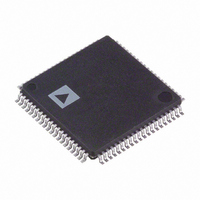AD9883AKSTZ-140 Analog Devices Inc, AD9883AKSTZ-140 Datasheet - Page 13

AD9883AKSTZ-140
Manufacturer Part Number
AD9883AKSTZ-140
Description
IC FLAT PANEL INTERFACE 80-LQFP
Manufacturer
Analog Devices Inc
Datasheet
1.AD9883AKSTZ-140.pdf
(28 pages)
Specifications of AD9883AKSTZ-140
Applications
Displays, Monitors, TV
Interface
Analog
Voltage - Supply
3 V ~ 3.6 V
Package / Case
80-LQFP
Mounting Type
Surface Mount
Lead Free Status / RoHS Status
Lead free / RoHS Compliant
Available stocks
Company
Part Number
Manufacturer
Quantity
Price
Company:
Part Number:
AD9883AKSTZ-140
Manufacturer:
Analog Devices Inc
Quantity:
135
Company:
Part Number:
AD9883AKSTZ-140
Manufacturer:
ADI
Quantity:
455
Company:
Part Number:
AD9883AKSTZ-140
Manufacturer:
Analog Devices Inc
Quantity:
10 000
Part Number:
AD9883AKSTZ-140
Manufacturer:
ADI/亚德诺
Quantity:
20 000
Standard
VGA
SVGA
XGA
SXGA
Timing
The following timing diagrams show the operation of the
AD9883A.
The output data clock signal is created so that its rising edge
always occurs between data transitions, and can be used to latch
the output data externally.
There is a pipeline in the AD9883A, which must be flushed
before valid data becomes available. This means four data sets
are presented before valid data is available.
Hsync Timing
Horizontal Sync (Hsync) is processed in the AD9883A to elimi-
nate ambiguity in the timing of the leading edge with respect to
the phase-delayed pixel clock and data.
The Hsync input is used as a reference to generate the pixel
sampling clock. The sampling phase can be adjusted, with respect
to Hsync, through a full 360° in 32 steps via the Phase Adjust
Register (to optimize the pixel sampling time). Display systems
use Hsync to align memory and display write cycles, so it is
important to have a stable timing relationship between Hsync
output (HSOUT) and data clock (DATACK).
REV. B
DATACK
HSOUT
DATA
Table V. Recommended VCO Range and Charge Pump Current Settings for Standard Display Formats
Resolution
640 × 480
800 × 600
1024 × 768
1280 × 1024
Figure 7. Output Timing
t
CYCLE
t
SKEW
t
PER
Refresh
Rate
60 Hz
72 Hz
75 Hz
85 Hz
56 Hz
60 Hz
72 Hz
75 Hz
85 Hz
60 Hz
70 Hz
75 Hz
80 Hz
85 Hz
60 Hz
75 Hz
Horizontal
Frequency
31.5 kHz
37.7 kHz
37.5 kHz
43.3 kHz
35.1 kHz
37.9 kHz
48.1 kHz
46.9 kHz
53.7 kHz
48.4 kHz
56.5 kHz
60.0 kHz
64.0 kHz
68.3 kHz
64.0 kHz
80.0 kHz
Pixel Rate
25.175 MHz
31.500 MHz
31.500 MHz
36.000 MHz
36.000 MHz
40.000 MHz
50.000 MHz
49.500 MHz
56.250 MHz
65.000 MHz
75.000 MHz
78.750 MHz
85.500 MHz
94.500 MHz
108.000 MHz
135.000 MHz
–13–
Three things happen to Horizontal Sync in the AD9883A. First,
the polarity of Hsync input is determined and will thus have a
known output polarity. The known output polarity can be pro-
grammed either active high or active low (register 0EH, Bit 5).
Second, HSOUT is aligned with DATACK and data outputs.
Third, the duration of HSOUT (in pixel clocks) is set via regis-
ter 07H. HSOUT is the sync signal that should be used to drive
the rest of the display system.
Coast Timing
In most computer systems, the Hsync signal is provided con-
tinuously on a dedicated wire. In these systems, the COAST
input and function are unnecessary, and should not be used and
the pin should be permanently connected to the inactive state.
In some systems, however, Hsync is disturbed during the Vertical
Sync period (Vsync). In some cases, Hsync pulses disappear.
In other systems, such as those that employ Composite Sync
(Csync) signals or embedded Sync-on-Green (SOG), Hsync
includes equalization pulses or other distortions during Vsync. To
avoid upsetting the clock generator during Vsync, it is impor-
tant to ignore these distortions. If the pixel clock PLL sees
extraneous pulses, it will attempt to lock to this new frequency,
and will have changed frequency by the end of the Vsync period.
It will then take a few lines of correct Hsync timing to recover
at the beginning of a new frame, resulting in a “tearing” of the
image at the top of the display.
The COAST input is provided to eliminate this problem. It is
an asynchronous input that disables the PLL input and allows
the clock to free-run at its then-current frequency. The PLL can
free-run for several lines without significant frequency drift.
VCORNGE
00
00
00
01
01
01
01
01
01
10
10
10
10
10
10
11
AD9883AKST
Current
110
110
110
100
100
100
101
101
101
101
100
100
101
101
110
110
VCORNGE
00
01
01
01
01
01
01
01
01
10
10
10
10
10
10
11
AD9883ABST
AD9883A
Current
011
010
010
010
010
011
100
100
101
011
011
011
100
100
101
101















